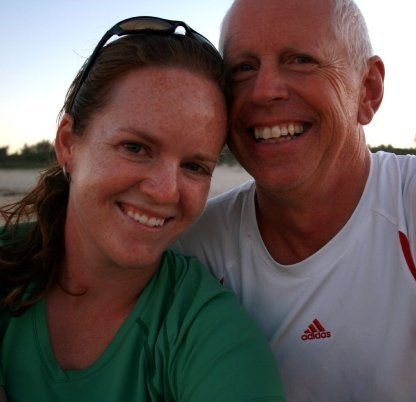


Once it was light enough, we set out to explore the temple itself. Built in the mid 12th century near the end of the monument building period at Angkor (about 870 to 1220 AD), King Suryavarman II constructed Angkor Wat as a dedication to the Hindu god, Vishnu. It served as the state temple and is considered to be the largest religious structure in the world (in addition to being one of the Ancient Wonders of the World!). The complex was built to symbolize the shape of the religious universe, with the central towers symbolizing the mythical Mt. Meru, the inner courtyards symbolizing the continents, and the perimeter moat symbolizing the oceans. A long stone causeway leads up to the temple from the west, flanked by square ponds on each side. Inside the temple's walls, corridors encircle the towers on the outside and inside of the inner courtyard, and literally every wall surface is engraved with symbolic carvings. It reminded us a little of exploring the temples in Egypt - the structures were massive, ancient, and elaborately decorated. We wandered the courtyards and the corridors, admiring the detail in the engravings and trying to recognize the meaning based on what we remembered from the museum yesterday. Stone Buddah statues were placed here and there in the hallways, and some had been draped with gold cloth and surrounded by decorations and offerings. Monks would offer us burning incense to place at its feet, blessing our families as we did. Then he asked for money, of course. What else is new?! A strange warm mist hung in the air outside as the sun heated up the day, and we stepped back to admire the temple in the sunshine before walking back to the entrance to find Mr. Khen.






Several kilometers north of Angkor Wat is the ancient royal city of Angkor Thom, which was the last capital of the Angkorian Empire, built in the late 12th to early 13th centuries when the capital was moved from Angkor Wat. About 12km of stone walls enclose the city, which includes numerous large and small temples and other structures of various ages. The Bayon temple is the most elaborate, and it was our first stop. The king that built it wanted to always keep an eye on his people, so he adorned most of the 50+ towers with large carved faces that look all four directions and probably measure 5 or 6 feet across. We tried to avoid the throngs of tourists that swarmed the temple now that it was late enough for the masses to be out and about. Much of this temple had crumbled, and piles of broken columns and severely leaning walls were strewn everywhere. Reconstruction work was underway here and at many other temples as efforts are made to stabilize the remaining structures and locally restore the decorations that existed before a thousand years of erosion wiped them away.



Tourists lined up outside to ride elephants around the temples, but after gaining such an appreciation for them in Africa, we couldn't help but feel bad for the poor things. Beyond Bayon, the grounds were shaded by a nice open, leafy forest. Little temples were spread all over the place, and we made a valiant effort to visit and understand each of them. On one side of the main road through Angkor Thom, the Terrace of the Elephants extended 300m, where large 3D elephants were carved head to tail along its length. By the time we finished our loop of the complex, we had visited multiple giant gold Buddah statues, climbed to the top of multi-storey pyramids with very steep stairways, and politely fended off dozens of cute little Khmer kids doing their best to sell postcards and bracelets to tourists amongst the temples. They cracked us up, actually, because as soon as they saw our flags or asked where we were from, they always said "Ahhh, Canada - capital Ottawa! Stephen Harper prime minister, two official languages!" One kid was hilarious, he added "population 34 million... minus two!" They must all study the fact sheet on first world countries because we probably heard that whole schpiel over a dozen times today! Speaking of Canadians, we were surprised to come across a lot of them today - even a couple from Nelson and a family from Revelstoke.
A few smaller temples were scattered in the trees outside of Angkor Thom, but they were great because you could climb all over them without tripping over anyone else. It was pretty amazing to be able to explore them all so freely, really - structures and artwork a thousand years old out in the open for anyone to get right up to and climb all over.


The last temple we saw for the day was Ta Prohm, which turned out to be one of the most memorable. At all the other ones, vegetation has been completely removed to minimize its effect on the already deteriorating structures. At Ta Prohm though, nature has been left to take its course, and it seems to be fully intent on claiming back its land. Big shady trees surround the site, and in many places, huge strangler fig and silk-cotton trees have started to take over the temple. This was also the set for the Tomb Raider movie if that jogs a memory - there are places where the long, twisted roots of enormous trees have completely enveloped the structure as if to take a huge handful to crush. Steel reinforcing has been installed in a few places to resist the trees' strangle, but odds are pretty good that eventually nature will win this battle.




That was about all the temple stuff we could handle for one day, so we headed back to town and had a lazy evening to rest up for another day of temple hopping tomorrow!






Loving this pictures Pamela, especially the one looking down the hallway with all the pillars.
ReplyDelete